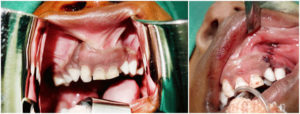Gingivoalveoperiosteoplasty
What is a Gingivoplasty?
Gingivoplasty refers to a procedure that is meant to reshape the appearance of an individual’s gums. When you have on your front teeth that are too long, it leads to the creation of a gummy smile. Gingivoplasty helps in fixing minor gummy smiles and is often accompanied by bone recontouring or crown lengthening.
A periodontist uses a tool to reshape or cut a portion of the gums during the gingivoplasty procedure. This medical procedure involves a scalpel, laser, or electrocautery. One of the benefits of using a laser for this procedure over a scalpel or other cutting tool is that it leads to the killing of bacteria present on the mouth and teeth.

There are times when a gingivoplasty is performed after a gingivectomy, with the latter being a procedure that is used to remove and replace damaged gum tissue. It is also often performed as a cosmetic procedure. During the process of gingivoplasty, your teeth are cleaned thoroughly to get rid of any remaining plaque. After that, a doctor makes use of a local anesthetic to numb your gums. They then proceed to remove gum tissue to shape it as required over your teeth. Lastly, a dressing is placed over your gum tissue.
A gingivoplasty could be needed for individuals who have undergone a gingivectomy with gum tissue grafting. This medical procedure can be used to reshape the grafted tissue for a more aesthetically pleasing look. It is also often combined with orthodontic treatments to give an individual a better smile.
The Case of a Gingivoalveoperiosteoplasty in Cleft
When an individual is between 6 to 10 years of age is when the clefts of the alveolus are typically treated, because that is when the bone can be taken from the hips or ribs and be packed into the defective area. The gingivoalveoperiosteoplasty in cleft requires the need for bone grafting at a young age. The gingivoalveoperiosteoplasty procedure and cleft palate repair gingivoperiosteoplasty make use of the higher regenerative potential of children below the age of five.
The procedure of gingivoalveoperiosteoplasty in cleft or gingivoalveoperiosteoplasty in plastic surgery is about raising a full mucoperiosteal flap from the neighboring tissue and sliding it over the cleft for the purpose of covering it. The cleft area is covered by the periosteum of the adjacent area. Periosteum is a tissue that is rich in osteoblasts, which are known as bone-forming cells. These deposit new bone into the defect, thereby filling up the alveolus.

At Richardsons Dental and Craniofacial Hospital, we ensure that the effectiveness of gingivoperiosteoplasty lasts for a substantial amount of time. We also fill the defect with platelet-rich plasma or PRP that is derived from the blood of the patient. A favorable environment for bone formation is created by growth factors released by the PRP. One of the examples of a gingivoalveoperiosteoplasty procedure being treated at our hospital is that of a young four-year-old boy with cleft alveolus. Regular follow-ups with the patients help the surgical team in identifying the patients who can be helped by a gingivoalveoperiosteoplasty procedure.

